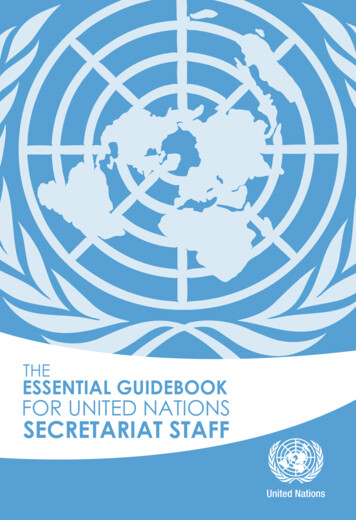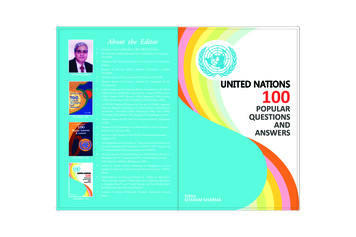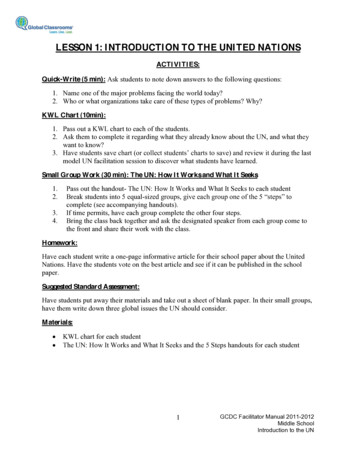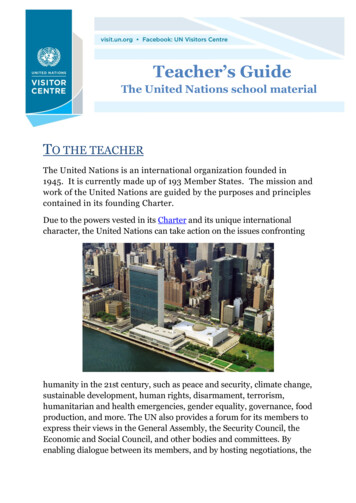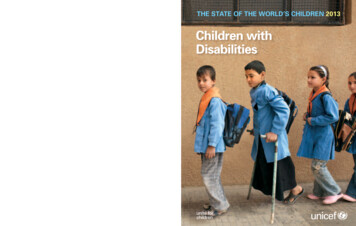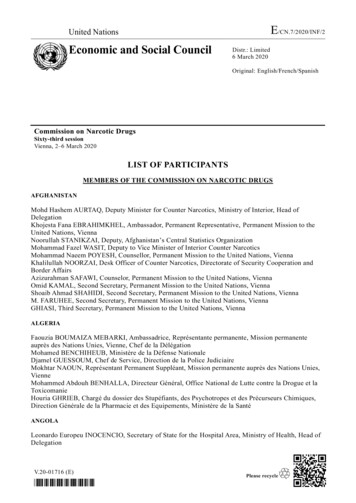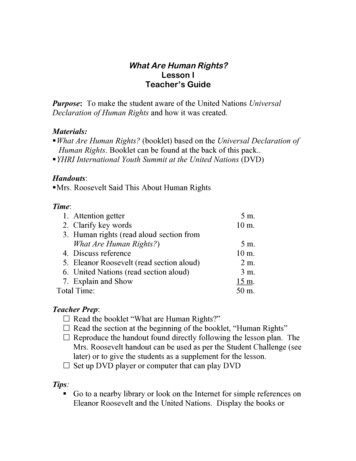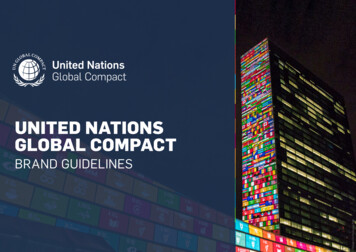
Transcription
UNITED NATIONS GLOBAL COMPACT BRAND GUIDELINES1UNITED NATIONSGLOBAL COMPACTPhoto: UN Photo/Cia PakBRAND GUIDELINES
UNITED NATIONS GLOBAL COMPACT BRAND GUIDELINES2CONTENTSINTRODUCTION TO BRAND GUIDELINES.32.3 BRAND STYLE. 29INTRODUCTION TO THE UNITED NATIONSGLOBAL COMPACT.42.3.1 Brand palette. 302.3.2 Colour pairings. 312.3.3 Typography. 32OFFICIAL BOILERPLATE TEXT.5PART I: HOW WE TALK1.1 TONE OF VOICE. 71.2 WRITING GUIDE. 91.3 ADDITIONAL GUIDANCE. .101.3.11.3.21.3.31.3.41.3.51.3.6Writing in the UN Global Compact way.1 1How we talk about ourselves.12How we talk about stakeholders.13How we talk about the Ten Principles.14How we talk about the Global Goals.15Translations.16PART II: HOW WE LOOK2.1 es.19Masterbrand logo and logotype.20Network logo and logotype.2 1Endorser logo.22Partnerships.23Logo sizing.24Logo colourways.252.2 ICONOGRAPHY.262.2.1 Icons: The Ten Principles.272.2.2 Icons: Sustainable Development Goals.282.4 IMAGERY. 342.4.1 Image sourcing. 352.4.2 Patchwork layout. 382.5 TEMPLATES. 392.5.1 PowerPoint. 402.5.2 Video and animation. 412.5.3 Email signature. 422.5.4 Stationery. 432.5.5 Publications. 442.5.6 Printing. 452.6 SOCIAL MEDIA. 462.6.1 Social media presence. 472.6.2 Social media guidance. 482.6.2 Logo on social media platforms. 49PART III: OUR SUB-BRANDS3.1 FLAGSHIP EVENTS. 513.1.1 TARGET GENDER EQUALITY LIVE: Logo. 533.1.2 TARGET GENDER EQUALITY LIVE: Brand Identity. 543.1.3 UN Global Compact Leaders Summit: Logo. 553.1.4 UN Global Compact Leaders Summit: Brand Identity. 57IN ORDER TO ENSURECONTINUED GROWTH ANDSTRENGTHENING OF THEUNITED NATIONS GLOBALCOMPACT BRAND ACROSSTHE GLOBE, A STRONGBRAND AND VISUALIDENTITY IS IMPERATIVE.These brand guidelines reflect our evolving approachto mobilizing responsible business in the era of the 2030Agenda and its 17 Sustainable Development Goals.This document also provides guidance for consistentexpression of the UN Global Compact brand everywhereit has a presence.Please contact the UN Global Compact Brand& Communications team with any questions atcommunications@unglobalcompact.org.This version is updated as of 17 November 2021.Click here to view the latest version.
UNITED NATIONS GLOBAL COMPACT BRAND GUIDELINES3INTRODUCTION TO BRAND GUIDELINESWHY DO WENEED A BRAND?WHY DO WE HAVEBRAND GUIDELINES?WHO ARE THESEGUIDELINES FOR?WHAT DOES THISDOCUMENT PROVIDE?For some, it may seem strange to think ofthe UN Global Compact as a “brand” givenour status as an initiative of the UnitedNations. While we do not have consumersin the traditional sense, the importance ofprojecting and protecting our identity throughbranding and communications still appliesto us. This is particularly important whenour values, mission and positioning needto be aligned across countries, helping ouraudiences understand exactly what we doand what we stand for.Consistently branded communicationscreate a point of difference with competitors,inspire and unite employees and attractnew business participants. Having a unified,professional brand and visual identity willenable us to build deeper relationshipsbetween the UN, businesses and otherkey actors to achieve the impact thatmulti-stakeholder partnerships can create.Put simply, strong communications arefundamental to achieving our mission.These brand guidelines are designed foruse by the UN Global Compact office in NewYork as well as our Local Networks aroundthe world. The UN Global Compact brandshould not be imitated by any other entity,including participants and partners of theorganization.These brand guidelines provide a frameworkfor consistently expressing the UN GlobalCompact brand across both visual andwritten communications. It is important thatboth of these mediums are given appropriateattention to achieve maximum brand impact.A strong brand is one that has a uniformidentity. With Local Networks around theworld and a need to emphasize our uniquerooting in the UN, it is imperative that wecommunicate using one voice and one visualidentity. It is also important that we distinguishourselves from other global sustainabilityinitiatives by establishing one UN GlobalCompact brand.Through enhanced brand awareness andcohesion across the globe and throughdeveloping materials that are consistent andof high-quality, the UN Global Compact ispositioned to generate greater impact.The biggest advantage to having brandguidelines is organizational recognition. Withrecognition comes familiarity. With familiaritycomes trust and confidence. If done correctly,consistency brings a clarity and purpose thataudiences recognize.By keeping our visual identity and brandingconsistent, we are able to effectively developand strengthen our brand, ensuring we makea strong, positive and long-lasting impression.While communications can — and should —be tailored according to channels, audiencesand markets, it is imperative that allcommunications sit within the parameters ofthese global brand guidelines as part of ourOne Global Compact strategy.This document provides both direction andpractical tips for application. Although ourbrand values are enduring, this document willevolve over time.
UNITED NATIONS GLOBAL COMPACT BRAND GUIDELINES4INTRODUCTION TOTHE UNITED NATIONSGLOBAL COMPACTThe United Nations Global Compact waslaunched in 2000 by UN Secretary-GeneralKofi Annan with the explicit mandateto “advance United Nations values andresponsible business practices within theUnited Nations system and among the globalbusiness community.”As a UN entity, the UN Global Compact isofficially chaired by the UN Secretary-General.The CEO and Executive Director reports tothe Secretary-General through the DeputySecretary-General.The Ten Principles of the UN Global Compactare all derived from core inter-governmentally-negotiated UN Conventions andDeclarations and have been recognized andendorsed in numerous UN General AssemblyResolutions, most notably the biennial“Towards Global Partnerships” resolution.The UN Global Compact is also referencedin intergovernmentally-agreed frameworkscentral to the 2030 Agenda, such as theAddis Ababa Action Agenda and the SendaiFramework for Disaster Risk Reduction.Today, the UN Global Compact is being calledupon to deliver even greater ambition andimpact. The initiative is uniquely equippedto help companies anywhere along theirsustainability journey — from beginners tothe most advanced leaders using businessas a force for good — meaning that we mustspeak the language of business, while stillrepresenting the values and principles ofthe United TO ACCELERATE ANDSCALE THE GLOBALCOLLECTIVE IMPACT OFBUSINESS BY UPHOLDINGTHE TEN PRINCIPLESAND DELIVERINGTHE SUSTAINABLEDEVELOPMENT GOALSTHROUGH ACCOUNTABLECOMPANIES ANDECOSYSTEMS THATENABLE CHANGETAGLINE:UNITING BUSINESSFOR A BETTER WORLD
UNITED NATIONS GLOBAL COMPACT BRAND GUIDELINES5OFFICIAL BOILERPLATE TEXTBoilerplate textbriefly summarizesan organization orcompany and can berepurposed in multiplecontexts withoutchange.The UN Global Compact boilerplate textis often added to the end of press releasesor the back cover of publications. GlobalCompact Local Networks are encouraged todevelop boilerplate text that is unique to theirNetwork.When possible, it is recommended touse the full boilerplate text, however amedium-length and one-line version havealso been provided when space does notallow for a longer version.Full boilerplate text (123 words)Medium-length boilerplate text (76 words)One-line boilerplate text (50 words)ABOUT THE UNITED NATIONSGLOBAL COMPACTABOUT THE UNITED NATIONSGLOBAL COMPACTABOUT THE UNITED NATIONSGLOBAL COMPACTAs a special initiative of the UNSecretary-General, the United NationsGlobal Compact is a call to companieseverywhere to align their operations andstrategies with Ten Principles in the areasof human rights, labour, environment andanti-corruption. Our ambition is to accelerateand scale the global collective impact ofbusiness by upholding the Ten Principlesand delivering the Sustainable DevelopmentGoals through accountable companiesand ecosystems that enable change. Withmore than 14,000 companies and 3,000non-business signatories based in over160 countries, and 69 Local Networks,the UN Global Compact is the world’slargest corporate sustainability initiative —one Global Compact uniting business fora better world.As a special initiative of the UNSecretary-General, the United NationsGlobal Compact is a call to companieseverywhere to align their operations andstrategies with ten universal principles inthe areas of human rights, labour, environmentand anti-corruption, and to take actionin support of UN goals. With more than14,000 companies and 3,000 non-businesssignatories based in over 160 countries, and69 Local Networks, it is the largest corporatesustainability initiative in the world.As a special initiative of the UNSecretary-General, the United NationsGlobal Compact is a call to companieseverywhere to align their operations andstrategies with ten universally acceptedprinciples in the areas of human rights,labour, environment and anti-corruption,and to take action in support of UN goals.For more information, follow @globalcompacton social media and visit our website atunglobalcompact.org.
UNITED NATIONS GLOBAL COMPACT BRAND GUIDELINESPART IHOW WE TALK6
UNITED NATIONS GLOBAL COMPACT BRAND GUIDELINES71.1TONE OF VOICEWhile voice determines whatyou say, tone determineshow you say it. Tone reflectsour style and attitude;it affects how informationis presented and how it isreceived. Tone of voice iscrucial for differentiatingourselves among otherorganizations. It needs to beconsistent — while we canadapt our voice for differentchannels and audiences,it should remain true tothe brand.Ultimately, we represent the UN and are tasked withembedding its values throughout the global businesscommunity. At the same time, we also represent thevoice of business at the UN, so our tone of voice needsto carefully balance these two groups and create ashared understanding.BRAND CHARACTERISTICSOur values and behaviours underpin everything we do andare reflected in everything we say. These in turn inform ourbrand characteristics — a set of human characteristics that areattributed to the UN Global Compact brand name, and to whichaudiences can relate.Our brand characteristics are:BUSINESS-FRIENDLYSpeak the language of business and emphasize our role as theUN-business liaisonCOLLABORATIVEReflect the inclusive, multi-stakeholder nature of our initiativeand encourage others to partner to solve complex challengesCLEAR AND CONCISEKeep language simple and direct, with e others to raise their ambition and play a key role increating the world we wantAUTHORITATIVEDemonstrate the utility of our unique, normative andprinciples-based approach
UNITED NATIONS GLOBAL COMPACT BRAND GUIDELINES8TONE OF VOICE SPECTRUMLike all good communicators, we adapt howwe speak depending on who we are talkingto, why we are talking to them and throughwhich channel. From personal and sociableto composed and formal, the tone of voicespectrum provides the flexibility to tailor yourmessage to achieve the best SED/FORMALChannel:Social media and blogsChannel:Press releases, Participant toolkits, emailcampaigns, infographicsChannel:UN correspondence, publications and reports,Executive UpdatesWhile our brand characteristics are notchannel-specific, the tone of voice spectrumdemonstrates how these characteristicsshould be executed across various channels.
UNITED NATIONS GLOBAL COMPACT BRAND GUIDELINES91.2WRITING GUIDEGETTING STARTEDTIPS FOR GOOD WRITINGREVIEWING YOUR WORKWe all need to influence and persuade, andwords are a central tool for communicatinga strong message. The tips and guidanceoutlined here should be thought of less asa set of rules and more as a gateway topurposeful, powerful language that is asenjoyable to read as it is to write.1. USE PRE-APPROVEDLANGUAGE WHERE POSSIBLE Document/article meets its intended purposeRemember: how you choose to approachcommunications depends on the audienceand what you are trying to achieve.Ask yourself:“WHO AM I WRITING FOR?”“WHAT DO THEY WANTTO KNOW?”“WHAT DO I WANT THEMTO DO?”Look to pre-existing materials(website, letters, emails, bulletin,etc.) and pull key phrases andlanguage where possible. Asthis material has already beenreviewed, referring to it in your ownwriting ensures that we are ableto consistently articulate our coremessages.2. KEEP IT SIMPLEAvoid long paragraphs, complexsentence structures and obscurewords. Write using short sentencesand simple words while emphasizingthe action the reader can take.3. GET TO THE POINTOpen with your conclusion or mostimportant point first. Provide themost relevant and compellingsupporting information next andend with background information.4. MAKE SURE YOURFOCUS IS CLEARFor full details on editorialguidelines, refer to the onlineUnited Nations Editorial Manual.Each section and paragraph shouldalso have a clear, singular focus.5. STRUCTURE TEXT SO THATIT IS EASY TO READAvoid heavy blocks of text and use bulletpoints, subheadings and other visual cuesto make information more manageable.Write for the allotted space.6. USE THE ACTIVE VOICEUse the active voice as a general rule.The active voice is more direct andconcise, and makes your writing strongerand more confident. Use the passive voiceonly if there is a specific reason to do so.7. AVOID JARGON ANDINDUSTRY-SPEAKJargon often confuses users andimpedes clarity. Avoid using it in mostcases. When industry-specific termsare the best way to communicate anidea, try to use them in a way thatnon-experts can understand as well.8. BE SUPPORTIVE ANDSOLUTIONS-ORIENTEDGood writing should address a reader’sproblem or answer a question they have.9. THINK BEYOND WORDSAdd a graphic, video/animation or chartwhere appropriate to bring data to lifeand better tell a story. Document/article written for targetaudience(s) Document/article focuses onthe main message Writing is scannable Get to the point Paragraphs and sentences are short Bulleted lists used where needed Bold formatting used to highlight key words Text is broken up using subheadings,graphics, call-outs, etc. No spelling, punctuation or grammar errors No double space between sentences Content is useful and easy to understand No buzzwords, jargon or industry-speak Active, conversational tone Titles that are meaningful, notunnecessarily clever or vague Clear, descriptive headings and subheadings Double-check that all hyperlinks work Writing complies with the onlineUnited Nations Editorial Manual
UNITED NATIONS GLOBAL COMPACT BRAND GUIDELINES1.3 ADDITIONAL GUIDANCE10
UNITED NATIONS GLOBAL COMPACT BRAND GUIDELINES1.3.1WRITING INTHE UN GLOBALCOMPACT WAYAS PART OF THE BROADER UNSYSTEM, THE UNITED NATIONSGLOBAL COMPACT FOLLOWSTHE WRITING STYLE ANDGRAMMAR RULES AS LAIDOUT IN THE UNITED NATIONSEDITORIAL MANUAL. THISSHOULD ALWAYS BE YOURFIRST STOP FOR GRAMMARAND STYLE-RELATEDQUESTIONS.11COMMON RULES: The correct punctuation is “a principles Avoid referring to the organization asbased approach” not “principle“UNGC” — it is ideal to use “United Nationsbased-approach”.Global Compact” (in full) the first timeit is written out, followed by “UN Global UN Agencies, Funds and Programmes shouldCompact” elsewhere; if absolutelynever be used in the possessive (e.g. younecessary, just the “Compact” is alsoshould not say “the UN Global Compact’sacceptable.staff” but rather “staff of the UN GlobalCompact”). “The Ten Principles of the UN GlobalCompact” is correct, while “10 Principles”and “The UN Global Compact’s TenPrinciples” are not. Whenever possible and appropriate,we should refer to the SustainableDevelopment Goals (SDGs) as theGlobal Goals. Dates should always be written out in theformat “Day/Month/Year” (for example,12 December 2018; rather than December12, 2018 or 12 December, 2019); similarly,the time of day should always be writtenin 12-hour format (for example, 3:30 p.m.rather than 3:30pm or 15:30). Acronyms should always be spelled outin full the first time, and then only writtenas the acronym (in all caps) each subsequenttime. In general, do not use an Oxford commaunless there are several “and” phrases. Know your dashes! The widest stroke, theem dash (—), should be used when dividingparts of a sentence to create emphasis.The mid-length stroke, the en dash (–), istypically used between dates and numberranges. The hyphen (-) should only be usedwhen hyphenating words. Government should always becapitalized when referring to MemberStates, either individually or in aggregate(for example, “ actors from business,Government, civil society and academia”).However, when referring to local, municipaland provincial governments, or whenreferring to non-governmental entities, the term is not capitalized. The terms “Heads of State” and “ChiefExecutive” should always be capitalized.Most words follow the British spelling with“ou” instead of just “o” (humour vs. humor);contrarily, most words use the American“z” instead of the “s” (organization vs.organisation). As a general rule, mostspellings closely resemble spellings inCanadian English (it may be helpful to setyour spell check accordingly).“Programme” is spelled with the extra“-me” on the end (as opposed to “program”),unless referring to a computer program.
UNITED NATIONS GLOBAL COMPACT BRAND GUIDELINES121.3.2HOW WE TALKABOUT OURSELVESUNITED NATIONSGLOBAL COMPACTThe name “United Nations GlobalCompact” communicates the origin andsignificance of the initiative to participantsand stakeholders around the world.Try to avoid abbreviations and use thefull name of the initiative whenever spaceallows it. The first time our organizationis mentioned, the full name should beused. Thereafter, “UN Global Compact”is recommended. The “Global Compact”is an outdated version of our name andshould not be used, as it omits the roleof the UN in our initiative. In speech orinformal correspondence, the “Compact”can be used as an abbreviation insubsequent mentions. “Compact” isalso a more appropriate abbreviation ascompared with “Global Compact”, as it isnot likely be confused to be the full nameof our initiative.Do not use the acronym “UNGC”or combined-acronyms like “UnitedNations GC.” The term “Global CompactOffice (GCO)” colloquially refers tothe UN Global Compact headquartersin New York, and should only be usedinternally when delineating betweenGlobal Compact Local Networks andthe UN Global Compact headquarters.The UN Global Compact name shouldnever be used in the possessive,i.e. “the UN Global Compact’s staff”is incorrect, whereas “the staff of theUN Global Compact” is correct.GLOBAL COMPACTLOCAL NETWORKSSISTERINITIATIVESGlobal Compact Local Networks advancecorporate sustainability at the nationaland regional level, helping companiesunderstand local opportunities, challengesand expectations. Organized and runlocally, Local Networks offer a venuefor both local firms and subsidiaries offoreign corporations to improve theirability to put sustainability commitmentsinto action and build local partnerships.Global Compact Local Networks shouldeach be referred to by their country- orregion-specific name (as expressed ineach Local Network Memorandum ofUnderstanding) — for example, “GlobalCompact Network Tanzania.” While thefull Network name (Global CompactNetwork Canada) should always be usedin the first instance, other shorthandversions that are acceptable in subsequentinstances include “Network Canada” andthe “Canadian Local Network.” Some LocalNetworks choose to use an acronym,such as “GCNT,” however we recommendavoiding this when possible and choosingfrom one of the recommended shorthandabbreviations noted above. The words“United Nations” and the “UN” acronymshould not be placed before the LocalNetwork name anywhere it appears.The UN Global Compact has a number ofsister initiatives, including the UN-supportedPrinciples for Responsible Investment (PRI)and Principles for Responsible ManagementEducation (PRME). These initiatives shouldalways be referred to independently by theirown names, ideally with reference made tothe fact that they are “sister initiatives” ofthe UN Global Compact.COMMUNICATIONON PROGRESS (CoP)The Communication on Progress (CoP) isthe most visible expression of a participant'scommitment to the Ten Principles of theUN Global Compact. Failure to issue aCoP may change a participant’s status tonon-communicating and can eventually leadto the expulsion of the participant from theinitiative.CoPs are made publicly available on thewebsite of the UN Global Compact atthe moment they are submitted by theparticipant. By serving as a report to keystakeholders, CoPs provide investors, civilsociety, Governments and consumers withinformation to make informed choices aboutthe companies they interact with.
UNITED NATIONS GLOBAL COMPACT BRAND GUIDELINES131.3.3HOW WE TALKABOUT OURSTAKEHOLDERSAlthough it is a business initiative at itscore, the UN Global Compact is builton a fundamental understanding thatmulti-stakeholder collaboration is necessaryto successfully achieve shared objectives. Assuch, we are committed to engaging a widerange of stakeholders in our work, including:business, investor groups, Governments, civilsociety, academia and UN Funds, Agenciesand Programmes.Some common guidelines to keep in mind whentalking about our business stakeholders are: The UN Global Compact is a voluntaryinitiative. Companies “sign on” to theinitiative, pledging their support to upholdthe Ten Principles of the UN GlobalCompact and to report annually onprogress made in support of the initiativethrough the mandated Communication onProgress (CoP). Therefore, the phrases“our members” and “our companies” areboth incorrect ways of referring to thoseorganizations that are part of the initiative. Additionally, while we colloquiallyrefer to all of our key stakeholders as“participants” of the initiative, there is, inreality, an important distinction betweenParticipants and Signatories. In line withour value proposition to companies, theUN Global Compact remains committedto strengthening and tailoring our supportfor business through these two distinctengagement tiers designed to suit differentcompany needs. For this reason, the terms Participantand Signatory (with capitalization)should be used whenever referring to anorganization’s specific engagement statuswithin the initiative. The broader term“participants” (without capitalization)may be used to collectively refer toorganizations engaged in the initiative,however it should only be used in situationswhere the specific engagement tiers arenot mentioned.
UNITED NATIONS GLOBAL COMPACT BRAND GUIDELINES141.3.4HOW WE TALK ABOUTTHE TEN PRINCIPLESThe Ten Principles of the United NationsGlobal Compact take into account thefundamental responsibilities of businessin the areas of human rights, labour,environment and anti-corruption. Drawnfrom landmark UN Declarations andConventions, they act as a normativeauthority for responsible business. Byincorporating the Ten Principles intostrategies, policies and procedures,and establishing a culture of integrity,companies are not only upholding theirbasic responsibilities to people and theplanet, but also setting the stage forlong-term success.The Ten Principles in action may bereferred to as our “principles-basedapproach”.HUMAN RIGHTSThe Universal Declaration ofHuman RightsLABOURThe International LabourOrganization Declaration onFundamental Principles and Rightsat WorkENVIRONMENTThe Rio Declaration on Environmentand DevelopmentANTI-CORRUPTIONThe United Nations Conventionagainst CorruptionWhen referred to in their proper sense, theTen Principles should always be written withthe number “ten” spelled out, with the firstletter of each word capitalized and with nointerruption between the words. Otherwise,they can be referred to in a more generalsense, such as “ten universal principles forresponsible business.”When the Ten Principles are referred tofrequently in a single paragraph, and not inconjunction with other principles (such asthe UN Guiding Principles or the Women’sEmpowerment Principles), subsequentreferences can be made to the “Principles.”For example, “The Ten Principles of theUN Global Compact are foundational tosustainable business. These Principles ”INCORRECT USAGE TO AVOID: The 10 principles The ten principles The UN Global Compact’s Ten Principles The Ten UN Global Compact Principles The Ten sustainability Principles
UNITED NATIONS GLOBAL COMPACT BRAND GUIDELINES151.3.5HOW WE TALK ABOUTTHE GLOBAL GOALSThe Sustainable Development Goals(SDGs) and the Global Goals are oneand the same. While both are acceptableterms, to determine which one to use, firstconsider your audience. If your audience islargely Government representatives, then“SDGs” may be most appropriate, as thisis the terminology that Member Statesspecifically adopted. “Global Goals” is aphrase that is considered friendly to thebusiness community and the general public.However, usage of both terms continuesto evolve and shift in popularity, and somebusinesses are more familiar with “SDGs.”In an effort to reduce, where possible, thenumber of acronyms and instead use moreapproachable language and phrasing, “GlobalGoals” is commonly used by the UN GlobalCompact.The SDGs were unanimously adopted by the193 Member States of the UN in 2015, butthey belong to everyone and should never bereferred to as the “Sustainable DevelopmentGoals of the United Nations.”The UN Department of GlobalCommunications (DGC) hasalso recommended thatGlobal Goals be used whenspeaking to a more generalaudience, with an emphasison social media through the#GlobalGoals hashtag.You can use both in onedocument, but we recommendnot frequently switching backand forth between the two. Forexample: “The 17 SustainableDevelopment Goals of the2030 Agenda are an ambitiousplan of action for people, planetand prosperity. These GlobalGoals belong to everyone, andthe business community has animportant role to play.”HOW WE TALKABOUT CORPORATESUSTAINABILITYThe UN Global Compact aims to be a learningplatform for corporate sustainability bestpractices around the world. Corporatesustainability starts with a company’s valuesystem and a principles-based approach todoing business, and should not be confused withcorporate social responsibility (CSR). While oftenused interchangeably, corporate sustainability andCSR have several key distinctions. CSR is typicallymore focused on the present and the recent past,from managing current stakeholder intereststo analyzing the last 12 months of a company’sactivities to assess its impacts on communitiesand the environment. Corporate sustainabilitygoes much further and examines how businessactivities should be executed over time to preserveresources and uphold human dignity for futuregenerations. For this reason, the UN GlobalCompact is a corporate sustainability — ratherthan CSR — initiative, and as such, the term CSRshould be avoided when referencing its work.
UNITED NATIONS GLOBAL COMPACT BRAND GUIDELINES161.3.6TRANSLATIONSTRANSLATE
THE FOLLOWING BRAND IDENTITY APPLIES TO ALL TARGET GENDER EQUALITY LIVE ASSETS. 3.1.2 TARGET GENDER EQUALITY LIVE: BRAND IDENTITY IMAGERY The objective is to use high-quality imagery that feels authentic, represents a diverse and global audience, and communicates the brand of the UN G
